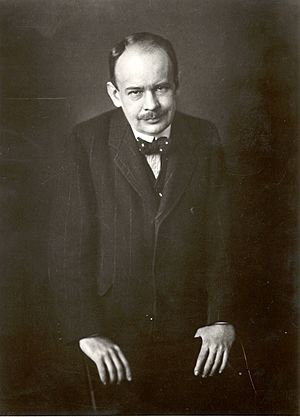Max Dvořák facts for kids
Quick facts for kids
Max Dvorak
|
|
|---|---|

Max Dvořák. Photo by Anton Kolm.
|
|
| Born | 4 June 1874 Roudnice nad Labem, Bohemia
|
| Died | 8 February 1921 (aged 46) Hrušovany nad Jevišovkou, Czechoslovakia
|
| Occupation | Austrian art historian |
Max Dvořák (born June 4, 1874 – died February 8, 1921) was an important art historian from Austria, originally from what is now the Czech Republic. He taught art history at the University of Vienna. He was part of a famous group called the Vienna School of Art History. They studied art by looking at the ideas and spirit behind it.
Contents
Early Life and Learning
Max Dvořák was born on June 4, 1874. His birthplace was Roudnice nad Labem in a region called Bohemia. His father worked as an archivist and librarian.
Max studied at the universities in Prague and Vienna. In 1897, he earned his PhD in history. This was at the Institut für Österreichische Geschichtsforschung in Vienna. He was very impressed by his art history teacher, Franz Wickhoff. Because of this, Max decided to focus on art history. He wrote a special paper about old books from Bohemia. These books had beautiful pictures drawn by hand.
His Career as an Art Historian
In 1902, Max Dvořák started teaching art history. He became a lecturer at the University of Vienna. After another important art historian, Alois Riegl, passed away in 1905, Max took over his role. With help from Julius von Schlosser, he became a curator. This meant he helped look after public monuments in Austria.
In 1909, he became a full professor of art history at the University of Vienna. This caused some issues. Some people at the university were unhappy because Max was of Czech origin. So, another professor, Josef Strzygowski, started his own art history center. This meant Max and Strzygowski taught art history from two different places at the same university.
Max Dvořák was a key figure in the Vienna School of Art History. One of his most important ideas was about art history as a "history of ideas." This meant he believed art showed the changing thoughts and feelings of people over time.
In 1905, he also took over from Riegl as the main curator. This was for the Imperial Central Commission. This group studied and protected art and historical monuments. Today, it is called the Bundesdenkmalamt. Max helped save many Austrian art treasures. This was especially important after World War I. He made sure these treasures were not taken as war payments.
He also continued to publish an important art history yearbook. In 1907, he started a list of Austrian and Hungarian monuments. This list was called Österreichische Kunsttopographie. In the same year, he created the first full catalog of the Lobkowicz Collections. In 1916, he published a well-known book. It was called Katechismus der Denkmalpflege. This book helped many people understand why it's important to protect old buildings and artworks.
Personal Life and Passing
Max Dvořák passed away on February 8, 1921. He had a stroke during a visit to a friend. This happened at Emmahof castle near Hrušovany nad Jevišovkou. He left behind his wife and two children. He was buried in the cemetery in Grusbach. His grave was an honorary one.
His Lasting Impact
Max Dvořák had a big influence on many other art historians. Some of them include Frederick Antal, Otto Benesch, and Hans Tietze. His writings show many of the ideas and challenges of the early 1900s. They help us understand how art history was studied back then.
His old papers and notes are kept at the University of Vienna.
In 1921, an Austrian architect named Adolf Loos designed a special building for Max Dvořák. It was meant to be a mausoleum, a grand tomb. However, it was never built. Later, in 2016, a smaller version of this design was put up. It was a temporary display at Highgate Cemetery in London.
Selected Writings
- "The Illuminators of Johann von Neumarkt." (1901)
- "The Mystery of the Art of the Van Eyck Brothers." (1904)
- Catechism of Monument Preservation (1916, 2nd edition, 1918).
- "Idealism and Naturalism in Gothic Sculpture and Painting." (1918)
- Oskar Kokoschka: Variations on a Theme. (1921)
- Art History as History of Ideas: Studies on Western Art Development. (1924)
- History of Italian Art in the Renaissance, 2 volumes. (1927–28)
- Collected Essays on Art History. (1929)
- The Paintings of Pieter Bruegel the Elder. (1942)
- "El Greco and Mannerism." (1953)
- Idealism and Naturalism in Gothic Art. (1967)
- The History of Art as the History of Ideas. (1984)
See also
 In Spanish: Max Dvořák para niños
In Spanish: Max Dvořák para niños
- Franz Wickhoff
- Alois Riegl
- Fritz Saxl

